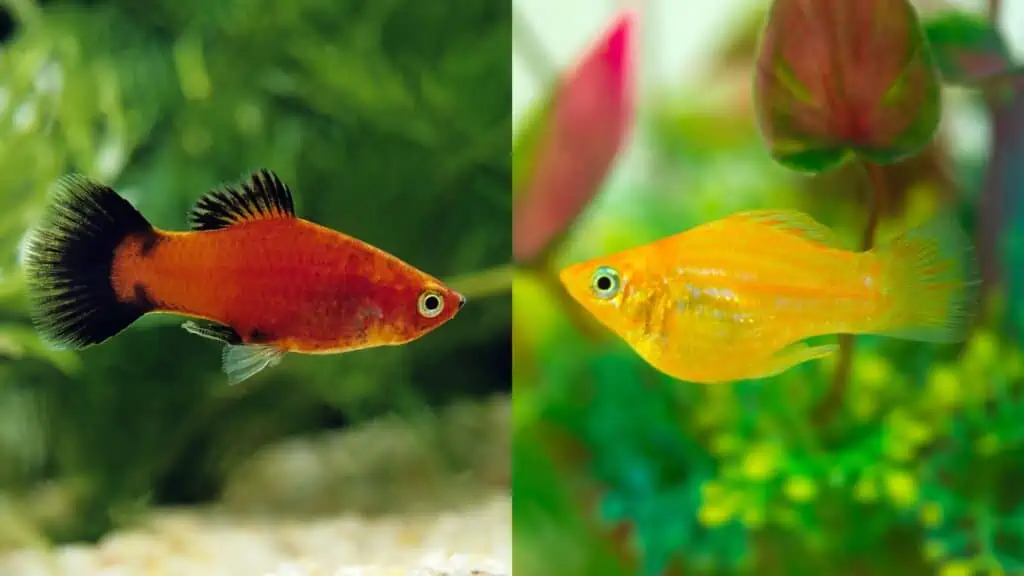Platies and mollies are two very similar species of tropical fish. So much so that many people get confused!
But I’m here to tell you that despite how similar they may be in appearance, these little guys are unique and special in their own way.
You don’t need to be an expert in fishkeeping to learn the biggest differences between them (or maybe you do – it took me a little while to get there!), but this article will help you learn more about both species of fish, so you can decide which is best for you.
And if you still can’t decide by the time you get to the end, why not just get both?!
Molly vs. Platy: Similarities and Differences
Whilst initially they may seem difficult to tell apart at first glance, having a similar facial appearance and being of a similar size, there are a few noticeable differences between them that are key in being able to identify one over the other.
To help simplify this, I’ve put together an easy-to-read table for you, highlighting the key similarities and differences between these two peaceful fish species.
| Similarities | Differences |
|---|---|
| They’re live bearers (They don’t lay eggs, just have lots of little babies!) | Platies have shorter and rounder bodies than mollies. They look ‘dumpy’, in comparison to mollies, which are sleeker and longer. |
| They have a similar facial structure. | Mollies are a little larger than Platies in general. |
| Mollies generally have brighter and more vibrant colors, such as green, black, white and, orange. Platies have warmer colors with red, yellow, orange, and white hues. | |
| Platies have spots! | |
| They’re from different species! The molly is from the Poecilia family and the platy is of the Xiphophorus. So despite looking like they could be twins, they’re actually not! |
Molly vs. Platy: Which Is Better?
It’s always difficult to say which is the better fish species. Both of these fish are great in their own way, so at the end of the day, it comes down to personal preference and experience.
As a personal opinion, it’s platies all the way! I remember first falling in love with these at an aquarium cafe (Yep! Those exist!) in South Korea. Not only were they super adorable, but what sold me on them was that the tank was buzzing with babies! Some are as small as a grain of sand!
Their little fat bodies and gorgeous orange color made me instantly drawn to them, and it’s down to that memory that they’re my favorite.
It must be noted here that many aquarium hobbyists actually agree.
Platies are generally favored due to their adorable appearance and bright colors and also because they require less meaty food. Though they require feeding three times a day, this generally makes it easier, as they’re able to eat well on a diet of flakes or pellets, as opposed to two meals a day of live or frozen food, as is recommended for Mollies.
Can Mollies and Platies Live Together?
Yes, mollies and platies make excellent tank mates!
With both of these fish being livebearers, they generally thrive in similar conditions.
Both species require alkaline waters and have a similar natural habitat. They’re also super friendly and peaceful community fish, meaning they’re not likely to harm each other.
Housing these two species together is a great combination for a community tank.
What Type of Water Does a Molly Need?
Most mollies have very similar fish tank requirements in terms of water parameters. Though the exact water parameters needed will vary depending on which species you own.
That being said, mollies are freshwater fish and generally very adaptable creatures. They generally enjoy warm water with a neutral pH. They can also live comfortably in freshwater environments, despite the common misconception that these fish only live in saltwater. Surprisingly, Mollies have the unique ability to live happily in both environments.
In order to ensure the water in your tank is appropriate for your molly, a reliable, accurate water test kit is a good investment. This helps you to understand the tank’s current state and when to make necessary adjustments to prevent your fish from getting ill.
The versatility of mollies can make them quite hardy fish. They experience various conditions in their natural habitat, as, whilst they’re mostly found in rivers, they can also occasionally be found in brackish waters and even the ocean!
In general, though, as a rough guide, it’s best to stick to the following water parameters for your Molly:
- Water temperature: 72°F to 78°F
- pH levels: 7.5 to 8.5
- Water hardness: 20 to 30 KH
What Size Tank Does a Platy Need?
When considering what size tank your platy needs, as with any fish, you also need to consider the decor, tankmates, and plants which take up space in their aquarium.
Platies like to live in small groups, and it’s recommended to house them with live plants, which help keep the water clean and break down waste produced by your fish. They are one of the favorite species among fish keepers.
That being said, a minimum of a 10-gallon tank is enough to house platy (a small group of 3) or a 20-gallon for them all to live comfortably. As I always say, the bigger the tank, the better. You’ll want to consider investing in a tank of a larger size if you’re planning on keeping them as part of a community set-up or as a larger group.
You’ll want space in your tank for the recommended group size of three to six Platies. However, as a live-bearing species, the males constantly want to mate, so if you’re mixing male and female Platy in your tank, one male to two or three females is recommended.
If your fish start breeding a lot, the population may spiral out of control, so make sure you either find new homes for the baby fish or if you don’t want to breed your Platies, ensure that the fish you are purchasing are all of the same genders before you add the group to your tank.
Also, if you’re feeling up to the challenge, platies can live in a pond! Adding your pets to an outdoor mini pond during the summer months is a great way for them to explore a new environment and get out and about to enjoy the sunshine – just be careful of any potential predators in the wildlife native to your area and secure your pond with netting if you choose to leave your fish outside.
How Many Platies and Mollies Can I Put in a 10-Gallon Tank?
If keeping mollies alone, a 10-gallon tank is suitable to house three fish. If housing them with platies, a pair of platy and a pair of mollies is usually the go-to. That way, they both have a friend! And you keep your fish safe.
Mollies are a slightly larger species than the platy and can grow to 3 and 4.5 inches in length, so a 10-gallon tank can house more platy if they live alone.
Despite their smaller size, you’ll still want to take care to prevent overcrowding, so you should house no more than five platies in a 10-gallon tank.
Can Mollies and Platies Interbreed?
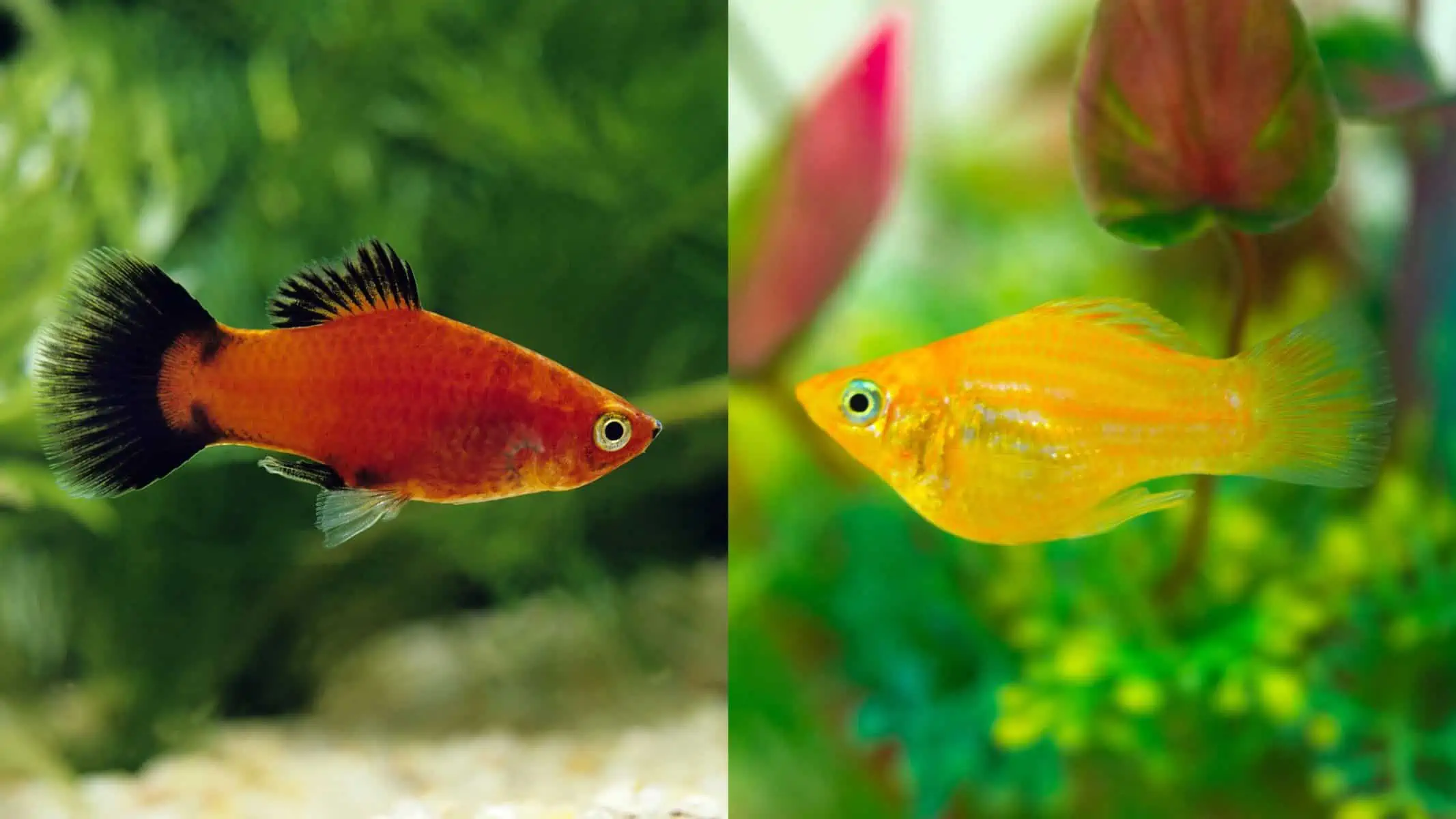
In short, no! Absolutely not! Mollies and platies are not able to breed with one another.
Mollies belong to the Poecilia family, and platies belong to the Xiphophorus family, so as these fish are of different species, crossbreeding is impossible.
That said, if you’d like to form a crossbreed between two different types of fish, platies are able to breed with swordtails, and mollies are able to breed with guppies, as they’re from the same family – If you’re an experienced breeder and have a few of these fish, perhaps give it a go!
Identifying Different Kinds of Mollies
Mollies are a highly diverse species, and so are popular aquarium fish, as there are so many subspecies with such versatile appearances.
To help you identify which kind of molly you may have (or maybe looking into purchasing), I have compiled a list highlighting some of the most common types of mollies and their most defining features:
Balloon Belly Molly:
- Balloon-shaped body (an arched back and round belly)
- Come in black, white, and yellow color combinations
- Lyre-shaped caudal fins.
Black Lyretail Molly:
- A hybrid variation of the Sailfin molly
- Black scales & white highlights on fins.
- Lyre-shaped caudal fins.
Black Sailfin Molly:
- Black scales
- Floaty long fins (avoid housing with fish that may nip these)
- Recommended for beginner fish keepers
Common Black Molly:
- Black scales
- Good for community tanks
Dalmatian Lyretail Molly:
- A color variation of the Sailfin molly
- Black and white patterned scales with a marble effect.
- Small, reaches a Max. of 3 Inches
- Good for beginner fish keepers
Dalmatian Molly:
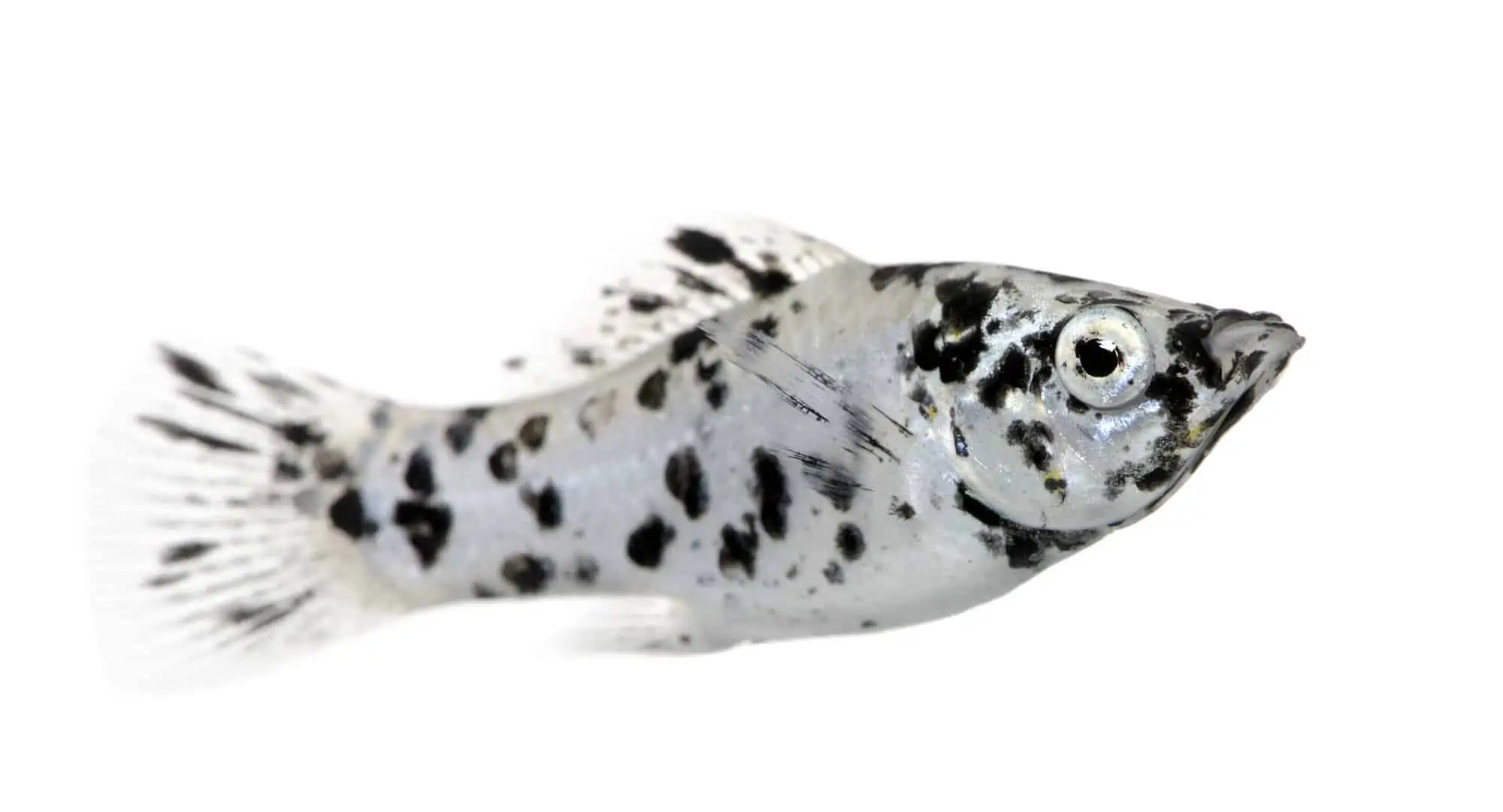
- Black and white patterned scales
- Bigger than the Common Black molly, an average of just under 5 inches
Gold Doubloon Molly:
- Short-finned variety
- Black and gold in color
Gold Dust Molly:
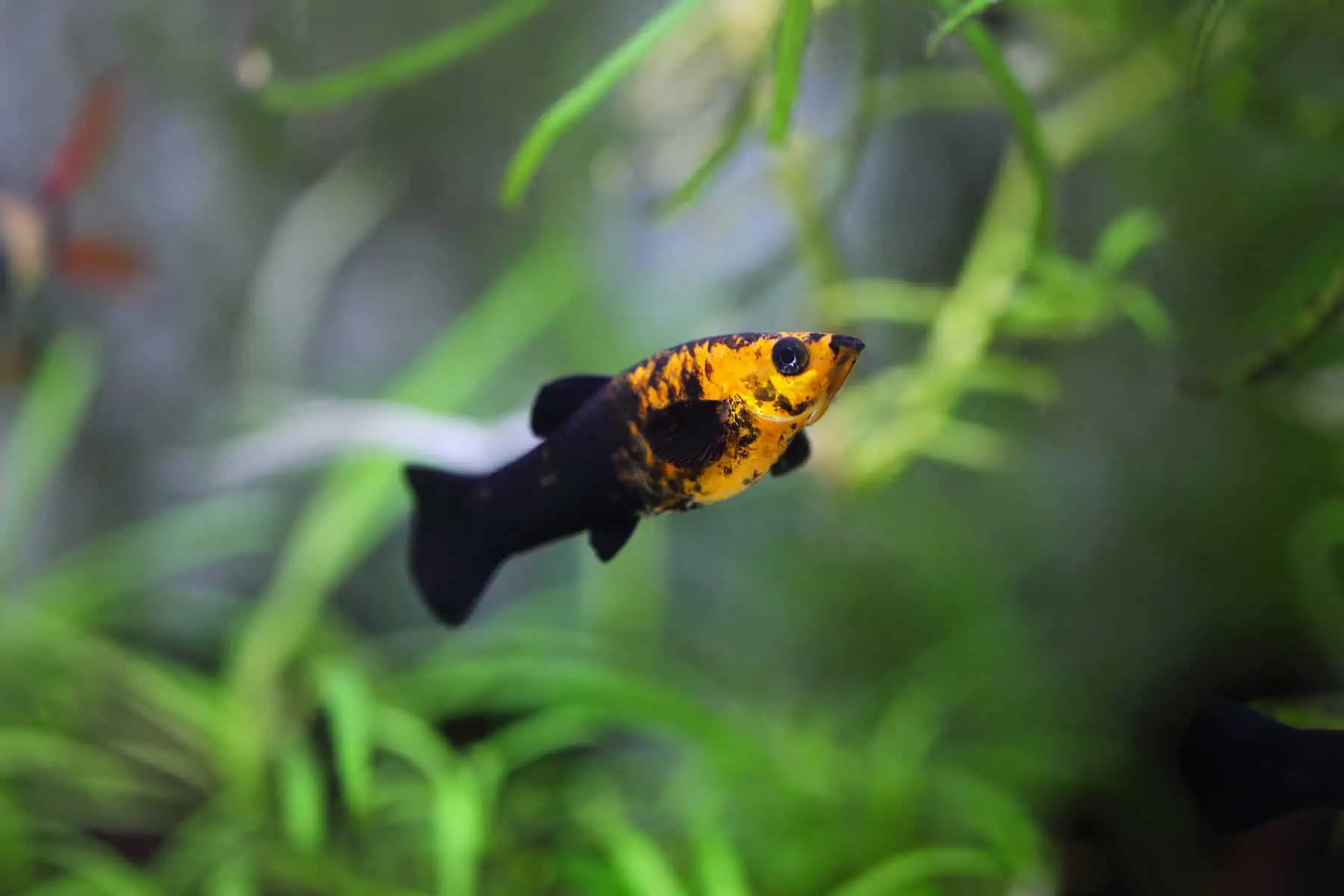
- Short-finned variety
- Dusty gold and black in color
- Males are more slender than females
- Females have a fuller shape
- Females develop a ‘pregnancy spot.’
Golden Sailfin Molly:
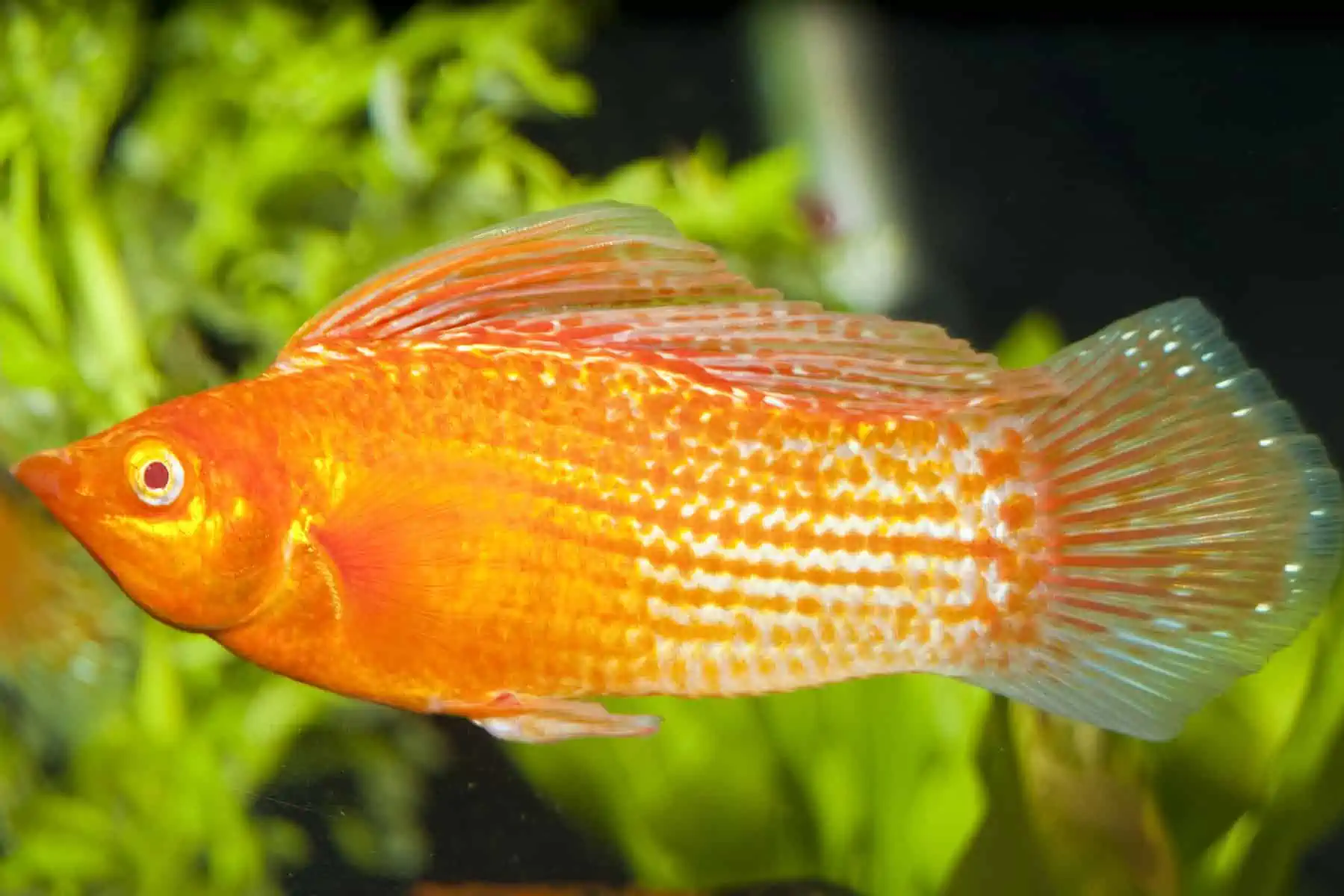
- Gold in color
- Grow a little larger than the average molly, so may require a larger tank
Harlequin Sailfin Molly:
- Gold, black, and white speckled patches
- Good for community aquariums
- Grow a little larger than the average molly
Marble Lyretail Molly:
- Black and white in color
- A variation of the Lyretail molly
- Males have a tall dorsal fin
Platinum Lyretail Molly:
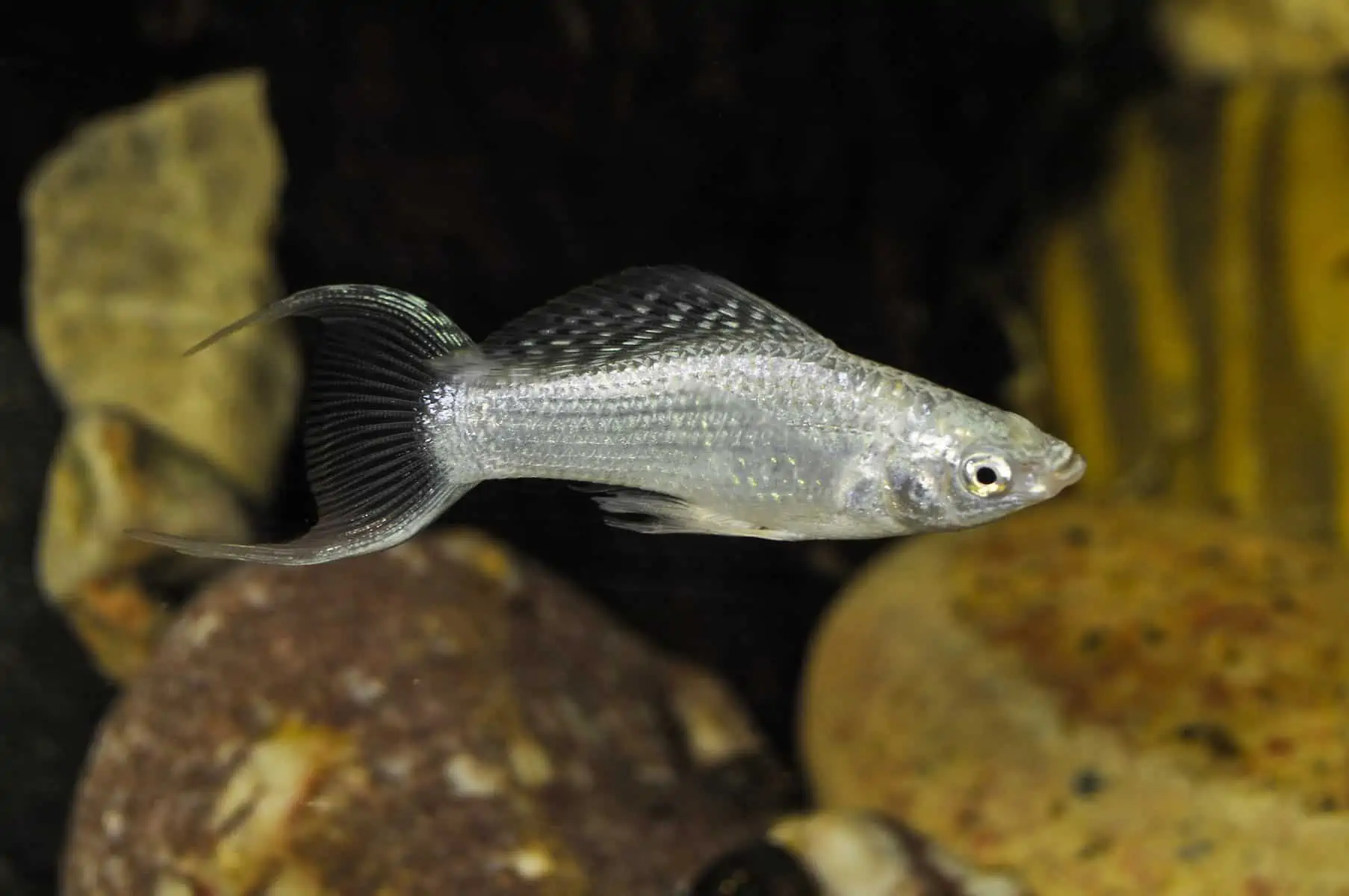
- Hybrid of Lyretail
- Platinum / gold in color
- Have a tall dorsal fin
White / Silver Sailfin Molly:
- Females grow larger and heavier than males
- Males are more colorful than females, with orange markings on their dorsal fins and turquoise markings on their caudal fins.
Identifying Different Kinds of Platy
Like the molly, platies are also incredibly diverse, making them just as popular a choice in home aquariums. There also exists many sub-species of platy, again with a wide variety in appearances.
To help you identify different kinds of platy, I have compiled a list highlighting some of the most common types and their most defining features:
Black Hamburg Platy:
- Black in color from the base of their tail to their head.
- Fins and head are red or gold in color.
- Closely related to the Green Swordtail.
- Easy to breed
- Good for a community tank.
Gold Red Platy:
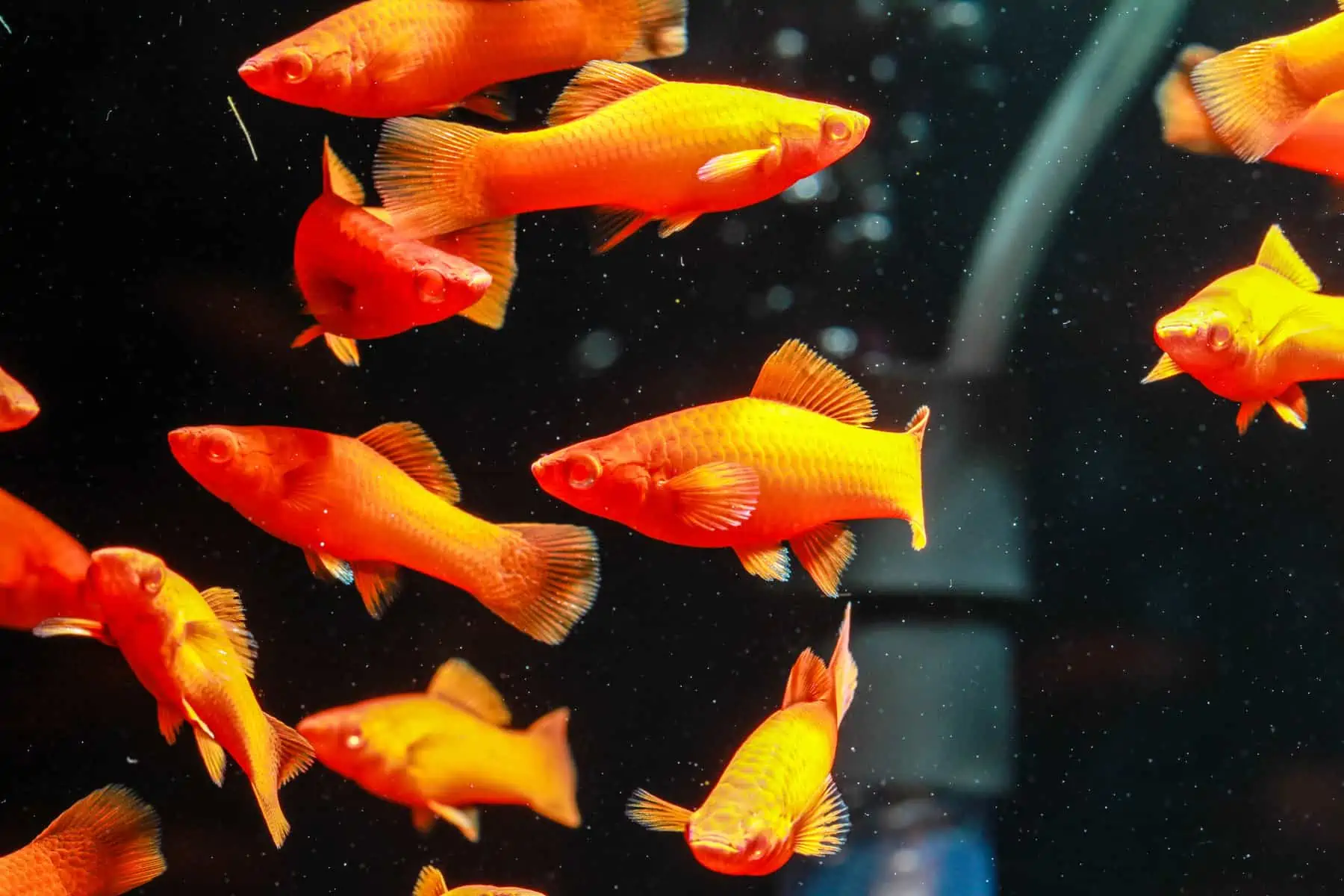
- Gold, red scales
- Rounded belly
- Some varieties have a translucent tail and fins
- Some varieties have a black tail and fins
Gold Twinbar Platy:
- Twin bar or Comet is a known color variation with a black mid-section on its sides and black-edged caudal fins.
- Usually bright yellow (or other common platy color variant) on the head, dorsal, and belly.
Hifin Tuxedo Yellow Platy:
- Hifin varieties have an elongated dorsal fin.
- Hifin varieties come in many colors or patterns.
- More prone to diseases that commonly attack the fins than other types of platy.
Mickey Mouse Platy:
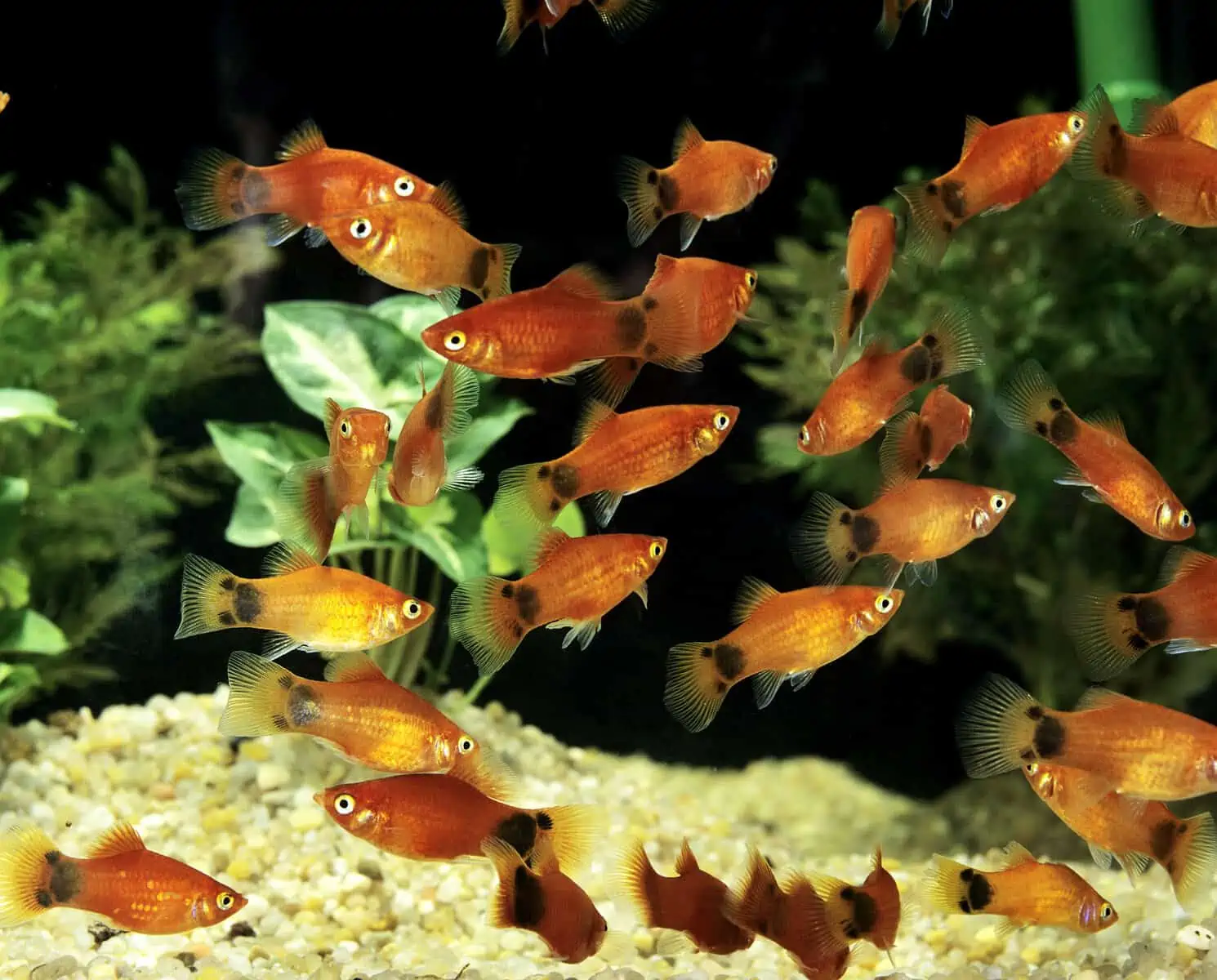
- Usually found in red and blue colors
- Black pattern at the base of its tail, a large black dot, and two smaller black dots, appearing like the popular Disney logo for Mickey Mouse.
Neon Blue Wagtail Platy:
- The Wagtail variety has black caudal and dorsal fins and a black tail.
- Appear neon blue in color and have some rosy gray scales.
Panda Platy:
- Closely related to the Green Swordtail, so much so that they are able to inter-breed.
- Has a black tail, which contrasts with the bright-colored body.
- Available in both the Pintail and Wagtail varieties.
Parrot Platy:
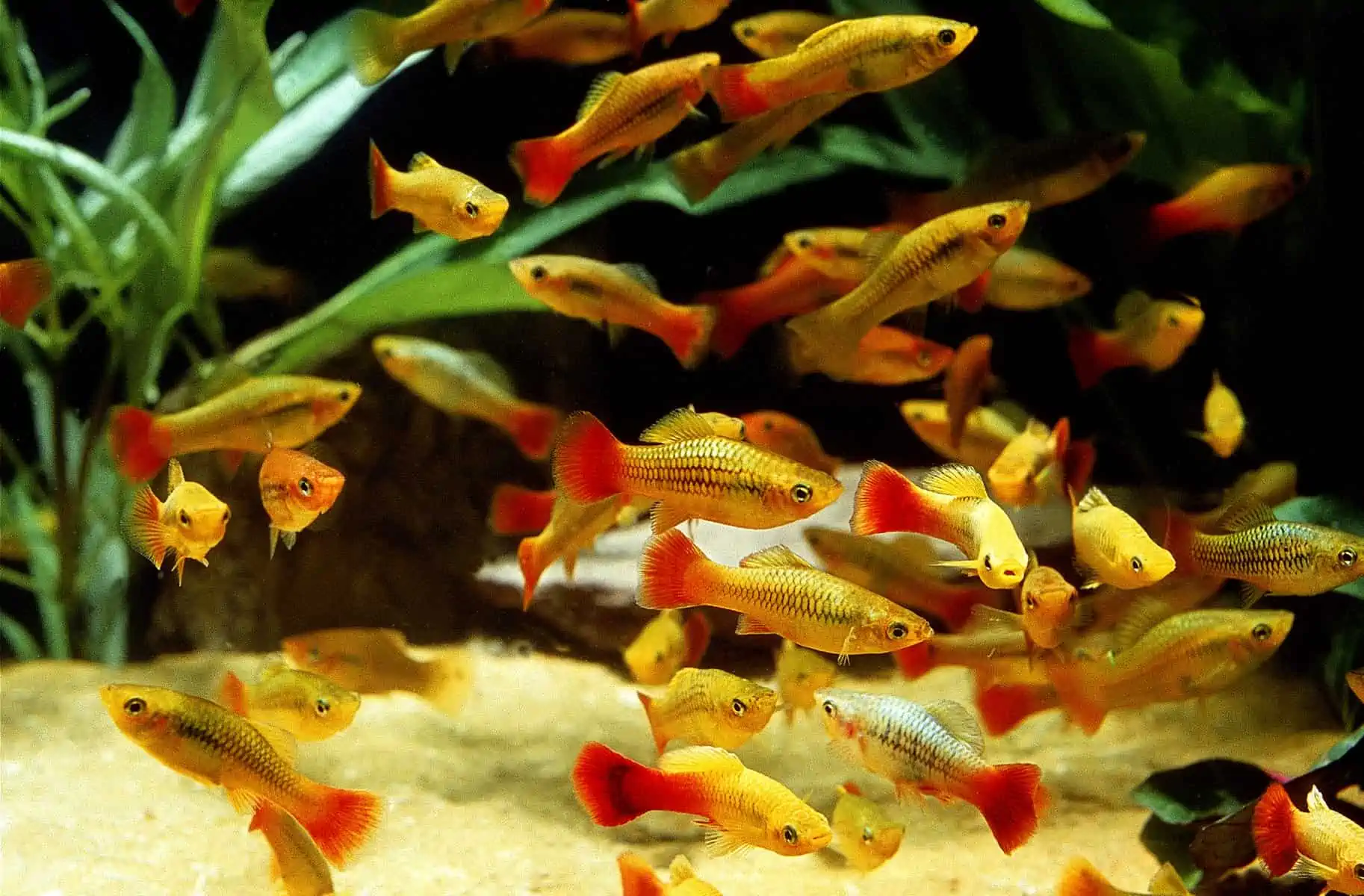
- Hybrid type
- V-shaped pattern on their tail makes them instantly recognizable, with two black stripes edging the margins of the tail.
- It can be found in gold, red, and yellow.
Pintail Rainbow Platy:
- Easily recognizable because of its unique and interesting tail, elongated in the middle, leading to this type being easily confused with a swordtail.
- Black, green, blue, and gold in color.
- Gold and black dorsal and caudal fins.
Rainbow Platy:
- Smaller in size than most platy, growing to around 2 inches.
- Good for beginner fish keepers as they’re easy to care for.
- Female platy are larger than males.
- Both are bright in color, but males have brighter colors, including yellow, orange, red, and iridescent colors.
Tuxedo Platy:
- The back end of the fish is black in color, and the front end is more bright in color (similar to a tuxedo).
- Popular in the aquarium trade.
- Sold under various names, e.g., ‘Platy Tuxedo Red’; ‘Platy Hifin Tuxedo Yellow’ etc.
It can be difficult always to tell mollies and platies apart. Still, hopefully, this article has given you further insight into both types of fish and helped you to define not only which of these popular breeds is which but also give you a better look at the sub-species of both platies and mollies.
To provide optimum care, you can consult a professional to determine whether your new pet is a platy or a molly (though there’s a good chance you knew this when you purchased him!). But any expert fishkeeper can also tell you what sub-species your fishy friend is!
Either way, both are just as great. And, as an added bonus, they’re both peaceful community fish that can live together in harmony! So don’t worry if you’re not 100% on what species of fish you have. Chances are they’ll all get along swimmingly!

